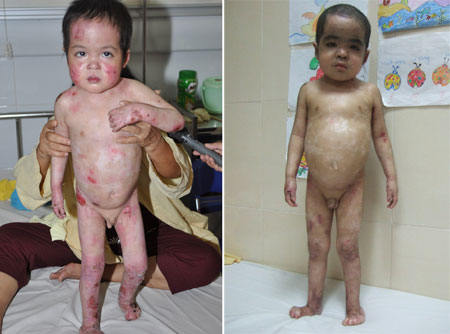
Vietnam has become only the second country in the world to successfully use stem cell transplant to treat Epidermolysis Bullosa (EB), an inherited connective tissue disease caused by problems with chemicals that cement the layers of skin together.
Vietnam has become only the second country in the world to successfully use stem cell transplant to treat Epidermolysis Bullosa (EB), an inherited connective tissue disease caused by problems with chemicals that cement the layers of skin together.
 |
|
Nguyen Viet Anh, 5, before (L) and 110 days after getting a bone marrow transplant to treat epidermolysis bullosa (EB) at the National Hospital of Pediatrics in Hanoi. |
Nguyen Viet Anh, a five-year-old boy with EB from the northern province of Vinh Phuc, was discharged from the Hanoi-based National Hospital of Pediatrics hospital on January 6 after a successful bone marrow transplant to cure lethal skin blisters last September.
He has totally recovered and is able to walk by himself, and most of the skin lesions on his body have disappeared.
Professor Nguyen Thanh Liem, who performed the transplant, said the boy has been given anti-rejection drugs and would undergo periodical checkups after returning home.
Anh was taken to various hospitals since he was born, but there was no hope that a treatment was available for his rare condition.
The boy was born blazing red with ulcerations in both hands and no skin or nails on the big toes, his family said.
He was diagnosed with EB, which ranges from mild to lethal but always involves a lot of pain as the skin becomes extremely fragile.
Children with EB lack type VII collagen, a protein that serves as the glue affixing the top layer of skin to the next. Friction — from a hug to a fall — can cause blisters the size of water balloons, which often leave behind scabs and scars. Children with EB are often confused with burn victims.
More blisters appeared as Anh grew up and the skin somehow formed a tight covering over his hands and feet.
On September 19, 2011 Prof. Liem led the procedure to conduct a bone marrow transplant with the marrow taken from his 10-year-old sister.
Forty days after the transplant Anh’s mother had said 80 percent of existing blisters were gone while fresh ones were smaller and healed faster.
Prof. Liem said Anh’s skin biopsy showed the presence of type VII collagen, indicating he no longer has the disease.
The world’s first successful transplant was made for Payton Thornton, a five-year-old boy, by doctors at the University of Minnesota in the United States.
Rising hopes
The day Anh was released from hospital, the National Hospital of Pediatrics said it had performed a second bone marrow transplant, this time on Le Anh Tu, a three-year-old boy, with marrow taken from his five-year-old sister.
Tu’s condition had been worse than Anh’s, with more blisters and a lot of ulceration in his eyes which would severely affect his eyesight and even cause blindness without early treatment.
Tu is reported to be rather well after the transplant.
“We will try to make bone marrow transplants to treat EB a normal procedure,” Prof. Liem told Vietweek Tuesday.
“Transplants at the University of Minnesota cost up to US$1 million; it costs just $25,000-30,000 in Vietnam.
“We will need to perform at least 10-20 transplants to prove the procedure a success,” Liem said.
The National Hospital of Pediatrics did both transplants free of charge, and plans to perform a third on a 17-year-old patient next May.
The challenges in doing transplants to treat EB include infection risks and the cost for poor families, as the hospital could not afford more free-of-charge transplants, Liem said.
Though Anh would be monitored closely for at least six months after the transplant, the surgery provided hope for around 60 children with EB who are undergoing treatment at the National Hospital of Pediatrics, he said.
“However, the problem is finding money for the treatment since most patients’ families are unable to afford the expenses,” he told Vietweek.
He also said that he received more phone calls every week from families of other children with EB.
(Source: TNNews)



